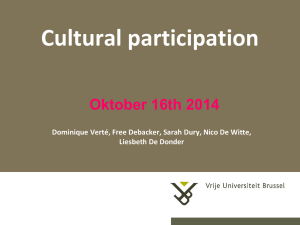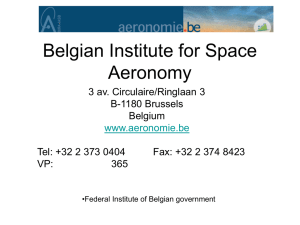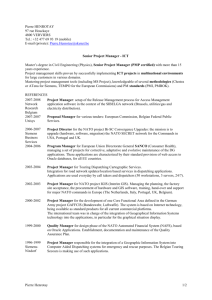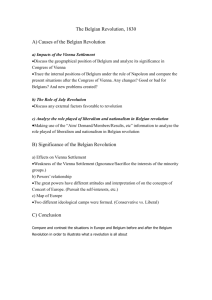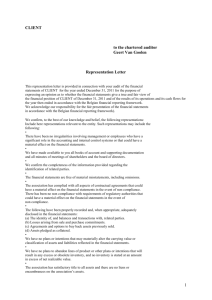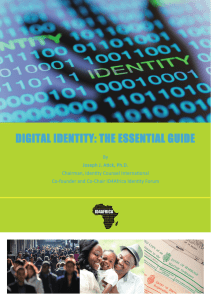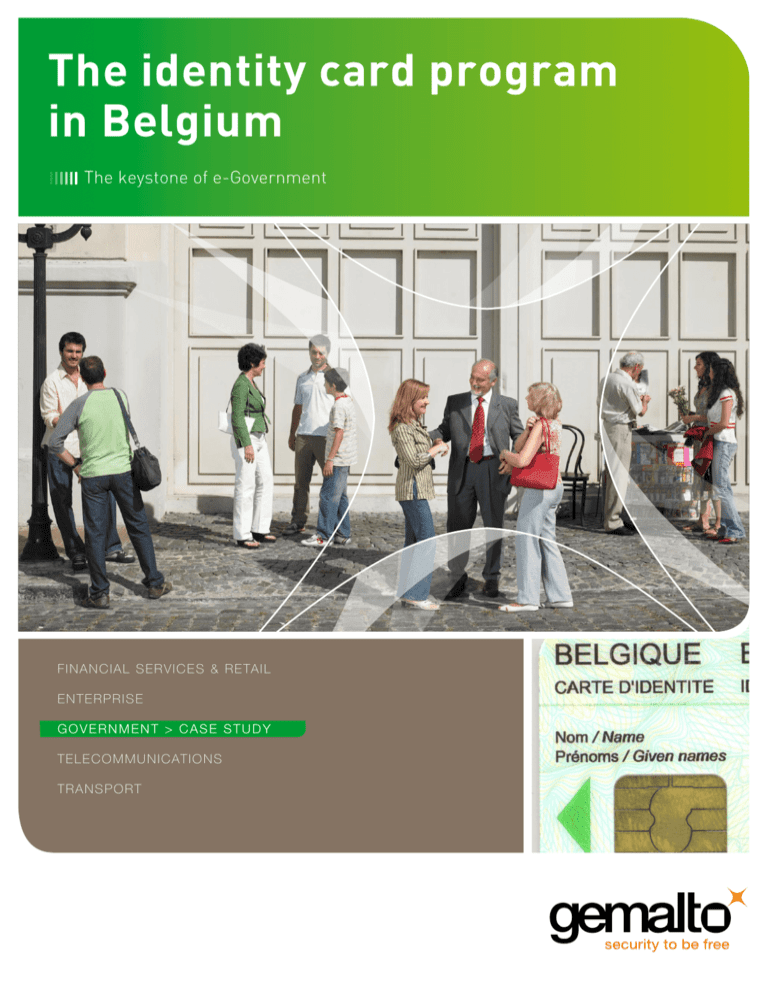
The identity card program
in Belgium
The keystone of e-Government
F I N A N C I A L S E R V I C E S & R E TA I L
ENTERPRISE
Government > CASE STUDY
T E L E C O M M U N I C AT I O N S
TRANSPORT
The identity card program in Belgium
The keystone of e-Government
The context
The Challenge
In July 2001, the Belgian
As one of the first countries in the world to
implement this measure on a national scale,
Belgium has had to set up an organization,
infrastructure, and brand-new technical framework, known as BelPIC (Belgian Personal
Identity Card). The aim was to provide Belgian
citizens with a secure identity document, but
also with a brand-new digital signature and
identification tool to access public and private
services online. This platform had to meet legitimate security, flexibility, and adaptability
requirements.
It also had to comply with European Directive 1999/93/EC on digital signatures.
Council of Ministers decided to
launch an electronic ID card for
all its citizens. This card was to
be the cornerstone of a wider
e-Government project, aiming
to simplify administrative
procedures, and modernize
public services.
Approved by the Belgian
Commission for the Protection
of Personal Information, and
Furthermore, a significant communication campaign had to be launched, in order to raise
awareness, and begin to prepare the 9 million citizens it was hoped to target by 2009.
passed by the Parliament
and Senate, the project was
officially launched in March
2003. The national deployment
of the card began in 2004.
The solution
To this end, the Belgian government created a new organization, the Fedict, a new PKI
infrastructure, the FedPKI, and a new inter-governmental technical framework.
The new secure identity card is now an official proof of identity for Belgian citizens.
There are many advantages to this system, such as faster and more secure access to
government services online, including tax services, online police reports, changes of
address, request for birth certificates and other certificates, declaring domestic staff,
etc. Each card holder has an individual PIN for authentication, and the card generates
a legally recognized signature.
The results
With more than 9 million cards in use by the end of 2009, the Belgian eID project
was the first to meet its targets in Europe, along with Estonia’s. The Belgian card
is the digital key for more than 600 e-applications on the internet (source: Fedict,
October 2009). Many public services are now available online, and procedures
which used to take hours now only take a few seconds. Through agreements with
other public institutions and many private service providers, such as Certipost
(a joint venture between the Belgian Post Office and Belgacom), as well as software
providers such as Microsoft and Adobe, citizens can send letters, PDF documents,
and signed contracts over the internet, or pay their bills online.
2
The Belgian eID cards
This is a “credit card” type version of the old identity card. It is classed as
electronic, since it has an electronic chip.
The e-ID lists the same information as the previous card. Some information
is listed both on the card and on the chip, while other information is only on
the chip (such as the address). It is be carried from the age of 15. 12 Euros
before the age of 18, and 17 Euros after the age of 18.
The residency card is a card without a chip for the part needed for travelling
abroad, and with a chip (on the back) to offer residents the same access
rights to online services as Belgian citizens.
For all foreigners (non-EU or Swiss) residing in Belgium.
16 Euros.
The Kids-eID allows children under 12 to rapidly be identified, either within
or outside Belgian borders. It is therefore a secure identity and travel
document. This card also allows the child (from the age of 6), to use the
internet in a safer way. Other uses can be developed, for example to
register or for identification at school, swimming pools, libraries, etc. An
emergency service is also linked to the card. An alert can be sent out if the
child has a problem or is in danger. If they so wish, parents can link this
central number to a list of telephone numbers which can be reached
in case of emergency. Around 3 Euros depending on the area.
This secure document is not compulsory.
How does it work?
Thanks to the chip, e-ID currently fulfils three functions: identification, authentication, and signature.
The first function of any ID card is to identify the holder.
The e-ID card contains exactly the same information as the traditional identity card but now the information is contained on
the chip. e-ID thus enables two different levels of identification:
> Visual face-to-face identification: thanks to the information visible on the card,
> Automatic identification: using data capture of the information stored on the chip. This identification can be done
remotely over the Internet.
This identification (either visual or automatic) does not, however, guarantee that the holder is the person they claim to be. To
verify this, authentication is required.
3
>>
The chip on the e-ID card is now used for the card’s second function: cardholder authentication.
This is a new function that did not exist with the former physical identity card. The electronic chip contains a digital
authentication certificate that ‘electronically’ proves the identity of the cardholder.
To identify himself, the citizen places the card in a reader and keys in a 4-digit PIN – just like one does for a banking
card. Authentication offers an even higher level of security than identification because it requires the cardholder to be in
possession of both card and PIN.
Authentication is an optional function that has the advantage of protecting the identity document against fraudulent
use. In Belgium, when citizens are issued with their e-ID card, they must declare to the issuing authority there and then,
whether they wish to activate the authentication option or not.
The third function is also new to this new generation of
identity document. A second certificate, located on the
chip in the e-ID card can add an authentic electronic
signature to electronic documents.
The electronic signature has the same legal value as its
paper equivalent. After having introduced the e-ID card
into the reader, the citizen keys in the PIN which then
generates a signature that is unique to the document.
The electronic signature is an optional function. In
Belgium, when citizens are issued with their e-ID card,
they must declare to the issuing authority there and then,
whether they wish to activate the signature option or not.
In our example, where the card is issued to a minor, the
signature option is automatically deactivated.
“Police on web” is one of 600 applications which use online identification in Belgium. Bike theft? Graffiti? Going on
holiday? Report it all directly on the internet! Since 100% of the Belgian population have eID cards, all citizens
can report thefts over the internet. This application is part of the measures to streamline administrative procedures.
Key events and dates
> September 2004 - Decree to expand the use of the e-ID electronic identity card – BELPIC project after the launch of
the pilot project in March 2003.
> December 2004 - Green light from the government to launch the Be-Health platform offering on-line healthcare
services, using e-ID and the SIS card.
> May 2005 - launch of the Federal Interoperability Framework for e-Government (BELGIF).
> January 2006 - Social Security enables salaries to be recorded on-line. Launch of the firste-Democracy projects
is done.
> November 2006 - second state/region cooperation agreement for an integrated e-Government. Launch of the ‘Safer
Internet’ website, whose secure use with e-ID prevents child abuse, enables anonymity to be managed in a secure
way and prevents spam containing illicit material.
> July 2007 - more than 5 million e-ID cards deployed.
Strategic plan 2007 for the knowledge society and e-Government is presented by the Minister for Employment and
Information Mr. Vanvelthoven.
> December 2009 - 100% of the target population has the eID. Over 9 million cards in circulation.
> February 2011 - 42% of Belgian children have a Kids-ID, more than 100.000 adults use the Fedict services to
authenticate when accessing internet gambling & betting (source Fedict 2011)
4
A remarkably transparent system
The “My File” application
>>
As part of the Belgian e-Government program, any Belgian citizen
can access the “My File” application after receiving their e-ID card.
With this application, Belgian citizens can consult all transactions
performed over the last 6 months by government officials who have
accessed files using their civil register data, from the National
Population Register, with the exception of exchanges relating to
State security (Justice and Homeland Security). The application
comprises an online form enabling citizens to request an official
explanation from the government body that accessed their private
data. The following information appears on the screen: the date
and time of access, the name of the person who consulted this data,
if the consultation was performed via identification with an electronic
card, the code of the institution which consulted the date, and finally
the name of this institution.
It says a lot that for months on end this application was consulted more than any other
when the Belgian e-Government program was started up. It has quickly come to be
considered to be a new right associated with the Belgian e-ID electronic Identity Card.
It has proven to be effective in ensuring uptake of the program, and Belgian citizens
subsequently eagerly awaited the roll-out of public services, and then semi-public
commercial services that the card could give them access to (Post offices, Transport,
local services, online police complaints, etc.).
A new right for Belgian citizens
The law which accompanied the distribution of the e-ID in Belgium led the government to offer
Belgian citizens the “My File” application, which can be accessed online, and which allows
people to know who has accessed their personal data. Therefore, a fundamental democratic
principle was complied with: when faced with a new constraint (digital footprints), provide a
new right (transparency).
A record is kept each time National Register data is accessed by a government official, noting
the identity and place of work of the official who accessed the personal data of a citizen and
the date of access.
The citizen can then consult their personal
databases, in the six months following
access. A query or complaints form is made
available to citizens, who can request that
the government provide a justification for the
recorded access. Police forces, by the very
nature of their duties, are of course exempt
from this requirement.
5
A remarkable implementation
approach
The Belgian e-Government is a service for everyone: so it had to be marketed
to the public
>>
The Belgian federal government has adopted a resolutely entrepreneurial
approach to e-Government. It has always considered e-Government as an
e-Service responsible for the public domain. The public has been familiar with
e-Services for nearly 7 years, or even more. It does not distinguish between
services. It acclaims innovative services that promote the user’s needs and show
an excellent understanding of the ‘web attitude’, and criticizes those that are still
dependent on the service-provider culture and constraints. The public wants its
interests to be put forward. Consumerism is a fundamental aspect of 21st century
culture and the public sector is no exception: the right service must be provided
to the right person, at the right time, and if possible with the most pro-active
approach.
The service must come to the user and not the opposite. This is a personalized
service; when people log in they are recognized, and their personal history of
dealings with the government are instantly recalled.
Knowing the customer and improving the service requires the right tool. That
tool is marketing. Belgian public authorities considered this was necessary for
the success of the project. Indeed, what is expected in the private sector should
also be expected in the public sector. “There are no excuses in today’s society
for a low quality service in the name of user equality».
Basic marketing principles and studies have therefore been applied according
to the 4 Ps: « Product – Price – Place – Promotion »
Product
The Belgian public authorities established several user workgroups - one per “customer” segment (essentially citizens and
businesses) - and creativity workshops. It was important for the priorities and attractiveness of the services to be in phase
to create a strong uptake. “We have of course focused work on services that use the e-ID card, as it was this card that we
wanted to promote to maximize political success and recognition.» This is how some services were created that no one
thought possible, such as:
>
>
>
>
electronic access via e-ID to local waste collection sites reserved for residents;
the ‘Kids ID’ card for the protection of children;
“Safer Chat”, where credentials must be shown in order to remain anonymous;
training and online monitoring of police complaints.
Price
Price elasticity has an effect on public services, particularly if online access is not mandatory and substitutions are possible
(price of the card, subscription, after-sales, developer kits).
“We defined them in a public-private partnership with our suppliers.”
The price of the card itself was set by taking into account the experiences of other countries (Finland, Sweden). It was not
acceptable for a Belgian family to pay 35 to 45 Euros per card and per person. The price of the Belgian Identity Card varies,
within a price bracket of 3 to 17 Euros, as described below.
6
Furthermore, the child protection service linked to the Kids-ID card, which was originally
going to be a paying service, was finally provided free of charge.
The equipment distribution network and the ease of access to the service is a determining
factor. “However, we have tried to add a ‘trendy/fashionable’ side, as we considered that
the product was still perceived as technological by our customers and that was an aspect
to be enhanced.”
So they then created ‘e-ID shops’ where trendy gadgets may be found and a high uptake
by ‘early users’ can be achieved, as this target population has the potential to recommend
and influence segments of the market where people are less easily convinced.
The e-ID online shop:
a good example of
product packaginghere for developers
Promotion
Communication is usually neglected by most e-Government policies. Unfortunately, communication should be considered as an
important aspect, as a major transformation of the relationship between individuals and institutions is taking place through the
administrative system that manages public services. Of course, the government is also being modernized for its own sake as well as
for the efficiency of the service it provides, but the effort to convince citizens and develop loyalty will continue for at least another
5 to 10 years.
The Federal Government plans to provide a considerable number of new services allowing the e-ID card to be used to carry out
transactions, and communications were improved in 2009 with a website, and a large number of local advertising campaigns. The
aim is to reach out to citizens (with the “My eID” bus, for example), and teach them to use the services, rather than waiting for them to
discover them by accident. The launch of a private-sector service provider without appropriate media communications
would be unthinkable.
There is no reason for the Belgian public service sector to act differently.
7
A remarkable service-oriented
application
Kids-ID: Belgian child protection services, both within Belgium and abroad
>>
Since the launch of the pilot scheme in 2007, the «Kids-ID», the new Belgian electronic identity document for children
under 12 has been a success from the start, especially as Belgium has seen some tragedies in terms of paedophilia
and child abductions.
Fedict, the Belgian Federal Public Service in charge of e-Government projects, launched the nationwide implementation
of Kids-Id in March 2009.
At the start of 2011, 42% of Belgian children had one of these non-compulsory cards.
The Kids-ID project is based upon the combination of an interactive protection service, an internet service, and
a specific version of the Belgian national ID card. Kids-ID is the same size as a credit card and holds secure
information. It offers three functions:
> It is first and foremost an official electronic identity and travel document that is compliant with the ICAO standard
valid in most European countries, and contains the identity data and the child’s photo stored on the electronic
chip. The parents’ name is also featured on the card.
>
8
Secondly, it protects the child in emergency situations. If the child is lost or has an accident, the card features
a telephone number that can be used to contact the child’s relatives. The caller dials the special number,
entering the eleven digits which identify the child on the national register. The call is immediately transferred to
the first number in a list that may feature up to seven contacts, selected by the parents when the card was
issued. If this person cannot be reached, the call is redirected to the second number in the list, and so on,
until somebody answers. If none of the contacts can be reached, the request is redirected to Child Focus,
a Belgian foundation for child assistance, accessible 24/7, which can be assisted by the national police force
if required.
>
Lastly, the Kids-ID card may be used on the internet for safer access to online chat
rooms and for services requiring ID. An integrated PIN code automatically identifies
children and only allows them access to those internet services that they are
allowed to use.
Kids-ID is not compulsory for
children remaining in Belgium.
Parents may, if they wish,
activate the cascading call
service, by telephone or via
this website, available in
three languages. A 3 Euro
contribution to the cost of
the card is invoiced to local
authorities. Kids-ID is a fine
example of cooperation with
Child Focus, the Foundation
for Missing and SexuallyAbused Children, a member
of Missing Children Europe.
Communications are focused
on parents, and promoted by
local authorities.
Highly secure, these cards offer endless possibilities. In the near future, it is envisaged that they may be used as library cards, sports
membership cards or perhaps even school attendance cards. It is also expected to replace the Social Security (SIS) card for children.
9
Impressive feedback from citizens
The «My MINFIN» tax service
>>
The collection of taxes and duties is, by its very nature, the area in which the State has the most trouble in getting
citizens onboard. With the “My MINFIN”/ my tax folder” application, Belgium took particular care to ensure that citizens
came onboard, while optimizing tax revenues and reducing fraud.
Paperless taxation procedures not only benefit the State, but also make citizens’ lives easier. For Belgium, it is a
powerful vehicle for the exercise of transparency and trust as well as a communication tool in illustrating the benefits
of paperless national procedures and their contribution to a general sustainable development approach.
The application has won over many citizens, all the more since it is very secure and confidential, and can be
personalized to meet individual needs.
Tax, like social security, is an area in which lightening the administrative burden can quickly bring about positive results,
not least in boosting the competitiveness of Belgian companies.
Thus, the tax sector, somewhat surprisingly, finds itself at the heart of a transformation process whereby a federal
government is moving towards both a more citizen-centric culture, by offering real personalized services, and a more
environmentally-friendly culture, with a widespread effort to make administrative procedures that affect millions of
households and businesses paperless.
My MINFIN (“my finance ministry”), is a comprehensive, personalized electronic tax folder listing the details of your
contacts, addresses, communications with the tax authorities, your property deeds, tax calculation tools, and progress
status for cases which are being processed. A success from the start, the number of citizens using this service doubled
between 2008 and 2009 (source ASA- Belgian agency for administrative simplification, November 2009). This is one of
600 personalized applications available in the country.
10
11
w w w. g e m a l t o . c o m
© 2011 Gemalto. All rights reserved Gemalto, the Gemalto logo are trademarks and service marks of Gemalto NV and are registered in certain countries. July 2011 - Design: Vincent Gregoire - Credit photos: Laurent Mauger et Gettyimages

